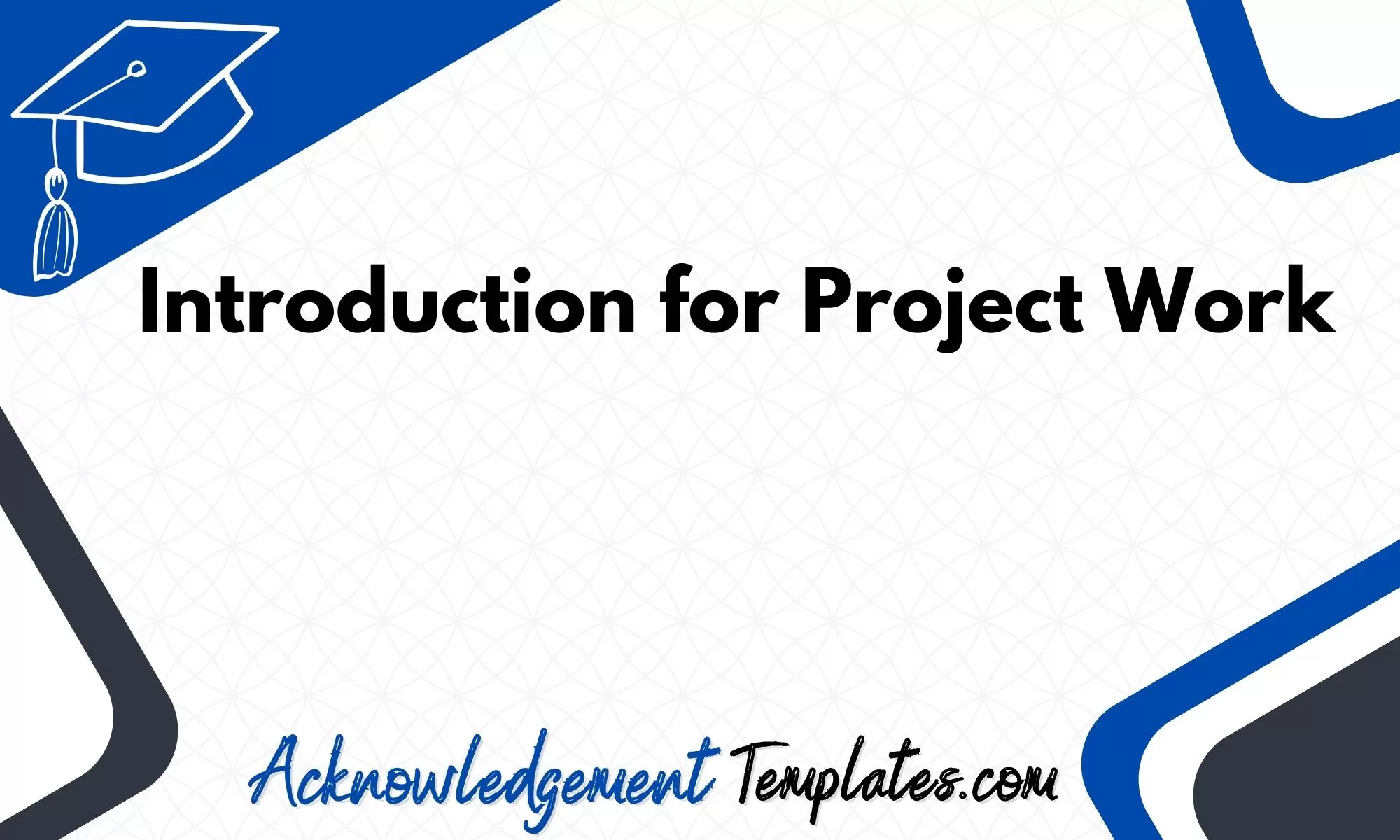Last updated on May 9th, 2024 at 07:22 pm
Crafting an introduction for project work entails stating its purpose, providing context, engaging the reader, outlining the structure, and summarizing key points succinctly.
Writing a compelling introduction is the key to engaging your audience and setting the stage for your project. The introduction serves as the first impression of your work, providing a roadmap for what to expect. In this ultimate guide, we’ll explore various strategies to craft an effective project introduction.
List Of Ways To Write Introduction For Project Work
- Write the project introduction at the End
- Identify the Purpose
- Summarize Your Actions for the Project
- Give a Background of the Topic
- Use of Headings
- Give an Outline of the Project
- Write Short and Clear
- Use of Bullet Points
- Proofread the Introduction
- Avoid Grammatical Errors
- Avoid Plagiarism Errors
- Give the Final Touch
- Engage Your Reader
- Establish a Connection
- Maintain Consistency
- Craft a Strong Thesis Statement
Write the project introduction at the End

Contrary to common practice, consider writing your introduction after completing the rest of your project. This allows you to encapsulate the essence of your work accurately, ensuring that your introduction truly reflects the content.
Tip: Use this opportunity to highlight the most significant aspects of your project, drawing attention to key findings and contributions.
Identify the Purpose
Clearly define the purpose of your project. What problem are you addressing, and why is it important? Understanding the purpose provides a solid foundation for the rest of your introduction.
Quote: “The purpose of life is not to be happy. It is to be useful, to be honorable, to be compassionate, to have it make some difference that you have lived and lived well.” Ralph Waldo Emerson
Summarize Your Actions for the Project

Offer a concise summary of the actions you took to complete the project. Briefly outline the methodology, tools, and techniques employed.
Addition: Elaborate on how your chosen actions were particularly relevant to achieving the project goals.
Give a Background of the Topic
Provide a contextual background for your project. Explore the historical, theoretical, or practical context that frames your work.
Variation: Consider discussing variations of the topic to highlight its evolution over time.
Use of Headings

Organize your introduction with headings. This enhances readability and allows readers to quickly grasp the main points.
Correlation: Ensure the headings correlate with the flow of your project, maintaining a logical progression.
More To Read |Acknowledgement For Email | Easy Steps
Acknowledgement For Job Offer|Examples & Templates
Give an Outline of the Project
Offer a brief outline of the project structure. This gives readers a roadmap, making it easier for them to navigate through your work.
Proximity: Arrange the outline in proximity to the subsequent sections, creating a seamless transition.
Write Short and Clear

Keep your introduction short and clear. Avoid unnecessary details and jargon, ensuring that your audience can easily comprehend the essence of your project.
Entities: Highlight the key entities or elements that are crucial to understanding your project.
Use of Bullet Points
Utilize bullet points to emphasize key points. This helps in breaking down complex information and enhances visual appeal.
Semantics: Ensure the bullet points convey the semantics accurately, providing a quick overview.
Proofread the Introduction

Thoroughly proofread your introduction for errors. Typos and grammatical mistakes can distract from your message.
Relevance: Make sure every sentence contributes to the overall relevance of the introduction.
Avoid Grammatical Errors
Ensure your introduction is free from grammatical errors. A polished introduction reflects positively on the overall quality of your project.
Synonyms: Employ synonyms judiciously to enhance the language and avoid monotony.
Avoid Plagiarism Errors

Steer clear of plagiarism. Acknowledge sources appropriately and use proper citations.
Contextual: Understand the contextual use of information and provide due credit to the original authors.
Give the Final Touch
Before finalizing your introduction, give it a final touch. Ensure that it aligns with the tone and style of the rest of your project.
Quote: “The difference between something good and something great is attention to detail.” Charles R. Swindoll
Engage Your Reader
Create an engaging introduction that captivates your reader’s interest. Pose questions, share anecdotes, or present a surprising fact related to your project.
Co–occurrence: Identify co-occurrences that resonate with your audience, making your introduction more relatable.
Establish a Connection
Establish a connection with your audience. Highlight the significance of your project in a way that resonates with their interests or concerns.
Entities: Align your project entities with the interests of your target audience.
Maintain Consistency
Maintain consistency in tone and style throughout your introduction. A cohesive introduction enhances the overall reading experience.
Variations: Introduce variations in your language to keep the reader engaged, but ensure consistency in conveying your message.
Craft a Strong Thesis Statement
Conclude your introduction with a strong thesis statement. Clearly articulate the main objective or argument of your project.
Correlation: Ensure there is a strong correlation between your thesis statement and the content that follows.
FAQs
What is an introduction sentence for a project?
An introduction sentence for a project is the opening statement that provides a brief overview of what your project is about. It serves as the starting point, offering readers a glimpse into the purpose and scope of your work.
What are the three sentences for your introduction?
In your project introduction, consider including a sentence that identifies the purpose, summarizes your actions, and provides a background on the topic. This three-sentence structure helps establish a clear foundation for your project.
What is a good example of an introduction sentence?
A good example of an introduction sentence could be: “In this project, we aim to investigate the impact of climate change on biodiversity, employing advanced data analysis techniques to uncover patterns and correlations within ecological systems.”
How can I introduce myself to a project?
When introducing yourself to a project, briefly mention your name, your role in the project, and your key contributions. For instance, “Hello, I’m James Wilson, the lead researcher for this project. I specialize in data analysis and will be exploring the correlations between variables to uncover meaningful insights.”
What is an example of a start-to-start project?
An example of a start-to-start project is a construction project where the foundation work begins simultaneously with the initiation of structural framing. This means that the two tasks, starting the foundation and starting the framing, have a dependent relationship, both commencing at the project’s initiation.
How do you write a strong introduction paragraph?
To write a strong introduction paragraph, begin with a hook to grab the reader’s attention. Clearly state the purpose of your project, summarize the key actions you took, and provide a brief background on the topic. Ensure clarity, relevance, and a smooth flow of information.
How do you start an introduction sentence example?
Start an introduction sentence with a captivating opening that intrigues your readers. For example, “Embarking on an exciting journey into the realms of artificial intelligence, this project aims to revolutionize data processing through innovative algorithms and machine learning techniques.”
Epilogue
In conclusion, this project stands as a testament to the diligent efforts invested in unraveling the intricacies of our chosen subject. The findings uncovered through meticulous analysis underscore the project’s significance in the broader academic landscape. As we reflect on the journey, it becomes evident that the synthesis of various methodologies has enriched our understanding.
The implications of these discoveries extend beyond the confines of this project, offering a compelling foundation for future research. In essence, this project serves as a springboard for continued exploration, with its enduring impact echoing through the corridors of knowledge.

I’m Matthew Porter, the creative mind behind “Acknowledgment Templates.” I’ve had a blast creating templates that capture the essence of gratitude in acknowledgment sections. At Acknowledgment Templates, we’re all about turning appreciation into a well-crafted art. Let’s make your acknowledgment section a masterpiece—join me in the creative process at Acknowledgment Templates!




